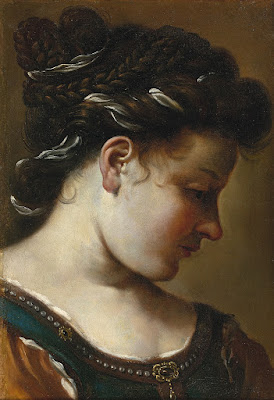 |
| Guercino (Giovanni Francesco Barbieri) Samson captured by the Philistines 1619 oil on canvas Metropolitan Museum of Art, New York |
 |
| Guercino (Giovanni Francesco Barbieri) Samson captured by the Philistines 1619 drawing (figure study, Samson) Fondation Custodia, Paris |
 |
| Guercino (Giovanni Francesco Barbieri) Samson captured by the Philistines 1619 drawing (compositional study) Metropolitan Museum of Art, New York |
"As noted by [Carlo Cesare] Malvasia, Guercino painted [Samson captured by the Philistines] in Ferrara in 1619 for Cardinal Serra, according to Roberto Longhi as a pendant to the Raising of Lazarus in the Louvre [directly below]. The pictures are similar in style, format, and composition, but, as Everett Fahy has noted, there is no obvious thematic connection between them. The present picture – long thought lost, but brought to the attention of Denis Mahon by Hugh Leggatt in the late 1970s – evidently passed from the cardinal into the collection of the Serra Dukes of Cassano at Naples. . . . It then descended in the family to Maria Teresa Serra di Cassano and her husband, Alfred-Bey Sursock, of Palais Sursock, Beirut, and thence to their daughter Yvonne, who in 1946 married Sir Desmond Cochrane (1918-79), 3rd Bt. It was purchased in 1979 by Mr and Mrs Charles Wrightsman, who bequeathed it to the museum in 1984."
 |
| Guercino (Giovanni Francesco Barbieri) The Raising of Lazarus ca. 1619 oil on canvas Musée du Louvre |
 |
| Guercino (Giovanni Francesco Barbieri) The Raising of Lazarus ca. 1619 drawing (compositional study) Metropolitan Museum of Art, New York |
 |
| Giovanni Battista Pasqualini after Guercino The Raising of Lazarus 1621 engraving British Museum |
 |
| Vivant-Denon after Guercino The Raising of Lazarus ca. 1792 etching British Museum |
 |
| Antoine-François Gelée after Guercino The Raising of Lazarus ca. 1804-15 etching and engraving British Museum |
 |
| Guercino (Giovanni Francesco Barbieri) Mary Magdalene (adapted from the sister of Lazarus, above) ca. 1619 oil on canvas Blanton Museum of Art, Austin, Texas |
 |
| Guercino (Giovanni Francesco Barbieri) Sister of Lazarus, or, Mary Magdalene ca. 1619 drawing (figure study) Ashmolean Museum, Oxford |
 |
| Guercino (Giovanni Francesco Barbieri) Sister of Lazarus, or, Mary Magdalene ca. 1619 offset-drawing (figure study) Ashmolean Museum, Oxford |
 |
| Guercino (Giovanni Francesco Barbieri) Head of a Girl ca. 1619 oil on paper (study head) private collection |
"This is one of the very few surviving oil studies on paper by Guercino. Presumably as an object lesson for his pupils, he set himself the challenge of creating an idealized head based on a live model, representing her black hair intertwined with white ribbons and relegating her pretty face to shadow. . . . The treatment of the girl's full and rounded ear fits precisely with Guercino's style of that moment, but also with his didactic activities of the same period. One of the 21 engravings that Oliviero Gatti (1579-after 1648) engraved after Guercino's series of drawings of anatomical and figure subjects, represents exactly similar ears [both drawing and engraving below]."
 |
| Guercino (Giovanni Francesco Barbieri) Studies of Ears 1619 drawing (for manual engraved by Oliviero Gatti) Morgan Library, New York |
 |
| Oliviero Gatti after Guercino Studies of Ears 1619 engraving (for published drawing manual) Harvard Art Museums |
 |
| Guercino (Giovanni Francesco Barbieri) St Alexius ca. 1619 oil on canvas private collection |
– quoted texts from The Paintings of Guercino: a revised and expanded catalogue raisonné by Nicholas Turner (Rome: Ugo Bozzi Editore, 2017)










































